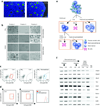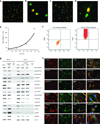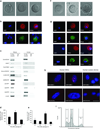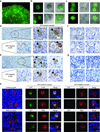Oocyte formation by mitotically active germ cells purified from ovaries of reproductive-age women
- PMID: 22366948
- PMCID: PMC3296965
- DOI: 10.1038/nm.2669
Oocyte formation by mitotically active germ cells purified from ovaries of reproductive-age women
Abstract
Germline stem cells that produce oocytes in vitro and fertilization-competent eggs in vivo have been identified in and isolated from adult mouse ovaries. Here we describe and validate a fluorescence-activated cell sorting-based protocol that can be used with adult mouse ovaries and human ovarian cortical tissue to purify rare mitotically active cells that have a gene expression profile that is consistent with primitive germ cells. Once established in vitro, these cells can be expanded for months and can spontaneously generate 35- to 50-μm oocytes, as determined by morphology, gene expression and haploid (1n) status. Injection of the human germline cells, engineered to stably express GFP, into human ovarian cortical biopsies leads to formation of follicles containing GFP-positive oocytes 1-2 weeks after xenotransplantation into immunodeficient female mice. Thus, ovaries of reproductive-age women, similar to adult mice, possess rare mitotically active germ cells that can be propagated in vitro as well as generate oocytes in vitro and in vivo.
Figures






Comment in
-
The quest for human ovarian stem cells.Nat Med. 2012 Mar 6;18(3):353-4. doi: 10.1038/nm.2699. Nat Med. 2012. PMID: 22395699 No abstract available.
-
Adult human and mouse ovaries lack DDX4-expressing functional oogonial stem cells.Nat Med. 2015 Oct;21(10):1116-8. doi: 10.1038/nm.3775. Nat Med. 2015. PMID: 26444631 No abstract available.
-
Woods and Tilly reply.Nat Med. 2015 Oct;21(10):1118-21. doi: 10.1038/nm.3964. Nat Med. 2015. PMID: 26444632 Free PMC article. No abstract available.
Similar articles
-
Use of DEAD-box polypeptide-4 (Ddx4) gene promoter-driven fluorescent reporter mice to identify mitotically active germ cells in post-natal mouse ovaries.Mol Hum Reprod. 2015 Jan;21(1):58-65. doi: 10.1093/molehr/gau071. Epub 2014 Aug 21. Mol Hum Reprod. 2015. PMID: 25147160 Free PMC article.
-
Production of offspring from a germline stem cell line derived from neonatal ovaries.Nat Cell Biol. 2009 May;11(5):631-6. doi: 10.1038/ncb1869. Epub 2009 Apr 12. Nat Cell Biol. 2009. PMID: 19363485
-
Adult human and mouse ovaries lack DDX4-expressing functional oogonial stem cells.Nat Med. 2015 Oct;21(10):1116-8. doi: 10.1038/nm.3775. Nat Med. 2015. PMID: 26444631 No abstract available.
-
Oogenesis in adult mammals, including humans: a review.Endocrine. 2005 Apr;26(3):301-16. doi: 10.1385/ENDO:26:3:301. Endocrine. 2005. PMID: 16034186 Review.
-
[Current progress and future direction in the biology of ovarian germ stem cells in mammals].Dongwuxue Yanjiu. 2012 Dec;33(6):586-90. doi: 10.3724/SP.J.1141.2012.06586. Dongwuxue Yanjiu. 2012. PMID: 23266977 Review. Chinese.
Cited by
-
Novel Approaches in Addressing Ovarian Insufficiency in 2019: Are We There Yet?Cell Transplant. 2020 Jan-Dec;29:963689720926154. doi: 10.1177/0963689720926154. Cell Transplant. 2020. PMID: 32686983 Free PMC article. Review.
-
Intraovarian injection of platelet-rich plasma in assisted reproduction: too much too soon?Hum Reprod. 2021 Jun 18;36(7):1737-1750. doi: 10.1093/humrep/deab106. Hum Reprod. 2021. PMID: 33963408 Free PMC article.
-
Ovarian stem cells: From basic to clinical applications.World J Stem Cells. 2015 May 26;7(4):757-68. doi: 10.4252/wjsc.v7.i4.757. World J Stem Cells. 2015. PMID: 26029346 Free PMC article. Review.
-
Fertility Preservation Methods in Breast Cancer.Breast Care (Basel). 2012 Jun;7(3):197-202. doi: 10.1159/000339671. Epub 2012 Jun 27. Breast Care (Basel). 2012. PMID: 22872792 Free PMC article.
-
Creating human germ cells for unmet reproductive needs.Nat Biotechnol. 2016 May 6;34(5):470-3. doi: 10.1038/nbt.3559. Nat Biotechnol. 2016. PMID: 27153270 No abstract available.
References
-
- Zuckerman S. The number of oocytes in the mature ovary. Rec. Prog. Horm. Res. 1951;6:63–108.
-
- Johnson J, Canning J, Kaneko T, Pru JK, Tilly JL. Germline stem cells and follicular renewal in the postnatal mammalian ovary. Nature. 2004;428:145–150. - PubMed
-
- Zou K, et al. Production of offspring from a germline stem cell line derived from neonatal ovaries. Nat. Cell Biol. 2009;11:631–636. - PubMed
Publication types
MeSH terms
Substances
Grants and funding
LinkOut - more resources
Full Text Sources
Other Literature Sources
Medical
Research Materials

